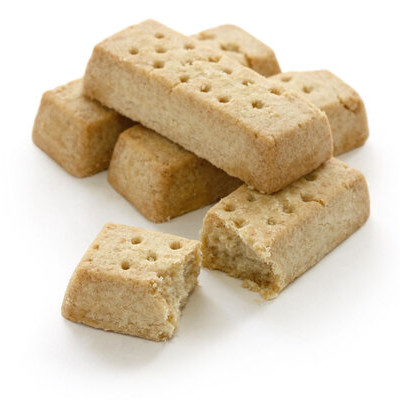Origin
Shortbread originated in medieval Scotland. It is thought to have been developed from the leftover dough of breadmaking, that was twice baked to form a dried and hard rusk.1 Eventually, the yeast from the dough was replaced with butter to provide the characteristic texture known today.1
Once considered an expensive luxury in Scotland and the UK, shortbread cookies are consumed everywhere today.1
Ingredients
Basic ingredients used in the production of shortbread cookies:
| Ingredient | Type1 | Usage level (Baker’s percentage) 1 | Function2 |
|---|---|---|---|
| Flour | Low protein flour (All- purpose wheat flour flour) | 100% |
|
| Butter or Shortening | Butter, margarine or shortening | 83.3% |
|
| Sugar | Granulated white sugar, or a mixture of white granulated sugar and icing sugar | 50% |
|
| Oat or Rice Flour | Finely ground | 33.3% |
|
| Flour | Granulated | 0.2% |
|
Nutrition
Typical nutritional value of commercially available shortbread cookies per 100 g:3
| Component | Grams |
|---|---|
| Carbohydrate | 56.67 |
| Fat | 26.67 |
| Water | 13.33 |
| Protein | 3.33 |
Shortbread cookies are highly caloric bakery products due to the high levels of sugar and saturated fats. A commercial shortbread cookie provides 500 kcal per 100 g serving.3
Commercial production
Shortbread cookies are commercially produced through the following process:2
- Scaling and weighing ingredients separately.
- First stage mixing or “cream up”: fat and sugars are mixed in a horizontal or vertical mixer.
- Second stage mixing: flour is added, and the mixing is continued at low speed to form a homogeneous mass.
- Resting: the mixture is left to rest for 30 min to allow hydration of the flour.
- Forming: dough is fed to a rotary moulding machine from a two roll sheeter.
- Baking: dough is baked at 205 – 230 oC (96 – 110 oF) depending on its thickness for 11 minutes.
- Cooling: cookies are cooled down for 5 min.
- Packaging and storage.
Application
Shortbread cookies can be made with plain wheat flour, oat flour, rice flour or a combination of two or three of them. For gluten-free formulations the use of rice or oat flour is recommended, the use of these alternatives will provide a sandy texture instead of a crumbly one.2
Considerations during processing:2
- Low water content, high sugar and fat are responsible for the cookie crumbly texture.
- High humidity at the beginning stages of the baking process is important for structure setting.
- Baking times depend on the thickness of the cookie, and they range from 6 – 13 minutes longer baking times are preferred over high temperatures.
- Second stage mixing should be minimal to avoid developing the gluten web.
Traditional shortbread cookies don’t have any leavening agents, however recent varieties are using it to provide a lighter texture.1
Regulations
Shortbread has a Commercial Item Description (CID) by the USDA, and it is considered a Type 1-cookie. All of its ingredients are considered safe by the FDA when following good manufacturing practices.4
In the EU, shortbread cookies are categorized in the Cereal and Bakery Products category, and as in the US all of its ingredients are considered safe.5
References
- Johnson, Ben. “The History Of Scottish Shortbread – Historic UK”. Historic UK, 2021, https://www.historic-uk.com/HistoryUK/HistoryofScotland/Scottish-Shortbread/ . Accessed 18 Apr 2021.
- Davidson, I. Biscuit, cookie and cracker production: process, production and packaging equipment. Academic Press, 2018 , pp. 6 – 158.
- U.S. Department of Agriculture, Agricultural Research Service. FoodData Central, 14 July 2017.https://fdc.nal.usda.gov/fdc-app.html#/food-details/1523316/nutrients. Accessed 18 April 2021.
- U.S Department of Agriculture. COMMERCIAL ITEM DESCRIPTION COOKIES The U.S. Department Of Agriculture (USDA) Has Authorized The Use Of This Commercial Item Description (CID).. United States Department Of Agriculture, Washington, 2007, pp. 1-2.
- Food Safety Authority of Ireland. Guidance Note On The EU Classification Of Food. Food Safety Authority Of Ireland, Dublin, 2001, p. 33

